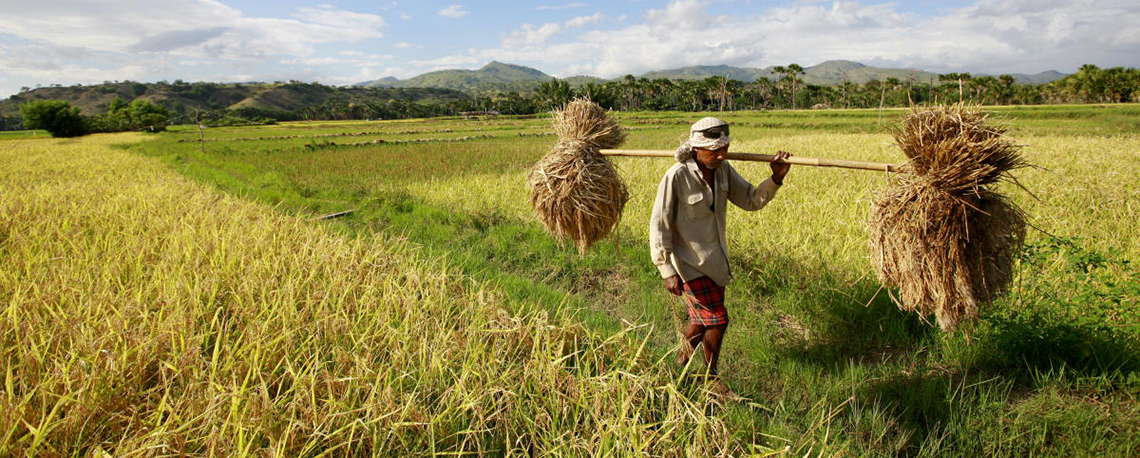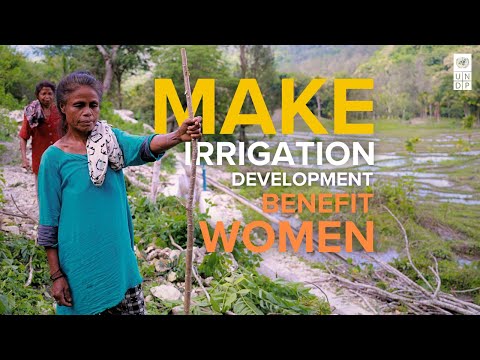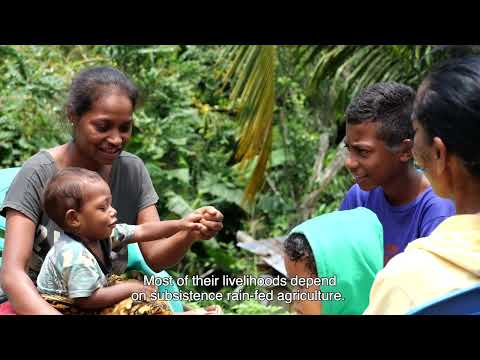In Timor-Leste, increasing climatic variability and unpredictability – particularly related to rainfall and extreme weather events – present a significant risk to the lives and livelihoods of rural people.
Climate-induced hazards, such as floods, landslides and drought, frequently impact families’ lives and livelihoods while also damaging critical rural infrastructure including water supply and drainage, embankments, roads and bridges. These damages leave rural populations without basic services and often in full isolation.
Targeting six municipalities that are highly susceptible to climate-related hazards, this six-year project (2020-2026) led by the Ministry of Commerce, Industry and Environment (General Directorate for Environment) focuses on:
• Climate risk reduction and climate-proofing measures for small-scale rural infrastructure, and
• The development and integration of climate risk into policies, regulations and institutions to inform rural infrastructure planning and management.
Key collaborators:- Country Office
- Local Governments
- National Governments
- Non-Governmental Organizations
- Private Sector Partners
- United Nations Development Programme (UNDP)
Primary beneficiaries:Approximately 175,840 direct beneficiaries in the 6 target municipalities (15% of total population)
Implementing agencies and partnering organizations:- National Directorate for Climate Change, Ministry of Commerce, Industry and Environment
- United Nations Development Programme (UNDP)
Project status:Under Implementation
Funding source:Green Climate Fund
Financing amount:US$22.9million via Green Climate Fund grant
Co-financing total:US$36.687 million via the Government of Timor-Leste; $400,000 via UN Development Programme
Project dates: 2020 - 2026
Location: Asia and the Pacific
, Timor-Leste
Expected outcomes
• Outcome 1: Climate risk information is developed, monitored and integrated into policies, regulations and institutions to inform climate resilient small-scale rural infrastructure planning and management
• Outcome 2: Climate risk reduction and climate-proofing measures for small-scale rural infrastructure are implemented to build the resilience of vulnerable communities in six priority districts
The GCF-financed project in partnership with the GoTL aims to safeguard vulnerable communities and their physical assets from climate change-induced disasters. First, the project will strengthen technical capacities of mandated institutions to assess and manage the risks of climate-induced physical damages and economic losses as well as integrate climate resilient measures into policies and planning. GCF funds will be used to embed new technical skills, improve availability of risk information, and create effective response mechanisms. Second, the project will implement climate risk reduction and climate-proofing measures for small-scale rural infrastructure in order to build the resilience of vulnerable communities in six priority districts. GCF funds will be used to introduce engineering skills for climate proofing of small-scale rural infrastructure that are essential to reducing prevalent social and economic vulnerabilities that will only worsen with climate change. GCF resources will also be invested in the development and implementation of catchment management strategies, which will support landscape restoration and land stability as climate risk reduction and long-term resilience measures. The rehabilitation activities will be undertaken in the catchment areas located in the areas of small-scale infrastructure units.
Output 1: Climate risk information is developed, monitored and integrated into policies, regulations and institutions to inform climate resilient small-scale rural infrastructure planning and management
Activity 1.1 - Develop and deliver climate risk information services and vulnerability mapping to all sectoral institutions
Activity 1.2 - Establish a database system for monitoring, recording and accounting climate induced damages in order to inform climate risk reduction planning and budgeting
Activity 1.3 - Refine ordinances, regulations and associated codes and standards to enable climate proofing small-scale rural infrastructure
Output 2: Climate risk reduction and climate-proofing measures for small-scale rural infrastructure are implemented to build the resilience of vulnerable communities in six priority districts
Activity 2.1 - Climate risk reduction measures for small-scale rural infrastructure are fully integrated into the planning and budgeting cycles of Village and Municipal development plans
Activity 2.2 - Implementation of climate-proofing measures for small-scale rural infrastructure
Activity 2.3 - Supporting catchment management and rehabilitation measures to enhance climate resilient infrastructure and communities.
The primary responsibility for day-to-day project monitoring and implementation rests with the National Project Manager.
The UNDP Country Office will support the Project Manager as needed, including through annual supervision missions. Additional M&E, implementation quality assurance, and troubleshooting support will be provided by the UNDP Regional Technical Advisor. The project target groups and stakeholders including the NDA Focal Point are involved as much as possible in project-level M&E.
An Annual Project Report will be prepared for each year of project implementation, shared with the Project Board and other stakeholders.
Within three months after the third year of the project, interim independent evaluation will be conducted. The final project report, along with the terminal evaluation report and corresponding management response will serve as the final project report package. Semi-annual reporting will be undertaken in accordance with UNDP guidelines for quarterly reports produced by the Project Manager.
An independent Mid-Term Review will be undertaken and the findings and responses outlined in the management response will be incorporated as recommendations for enhanced implementation during the final half of the project’s duration.
An independent Terminal Evaluation will take place no later than three months prior to operational closure of the project.
Both the Mid Term Review and Terminal Evaluation will be carried out by an independent evaluator. The evaluation report prepared by the independent evaluator is then quality assessed and rated by the UNDP Independent Evaluation Office.
The UNDP Country Office will retain all M&E records for this project for up to seven years after project financial closure in order to support ex-post evaluations.


















